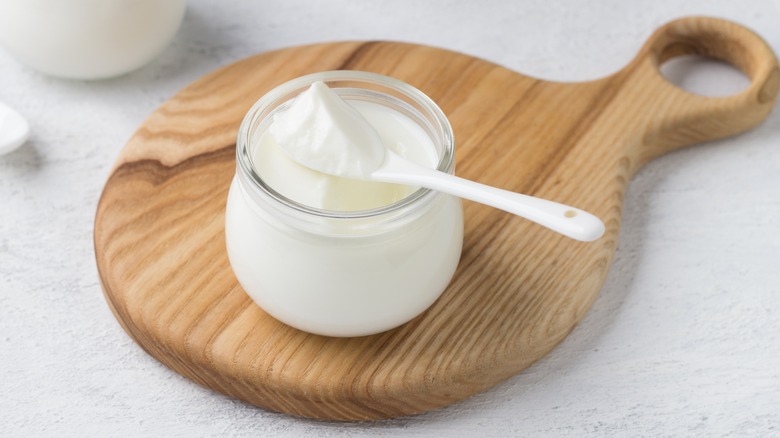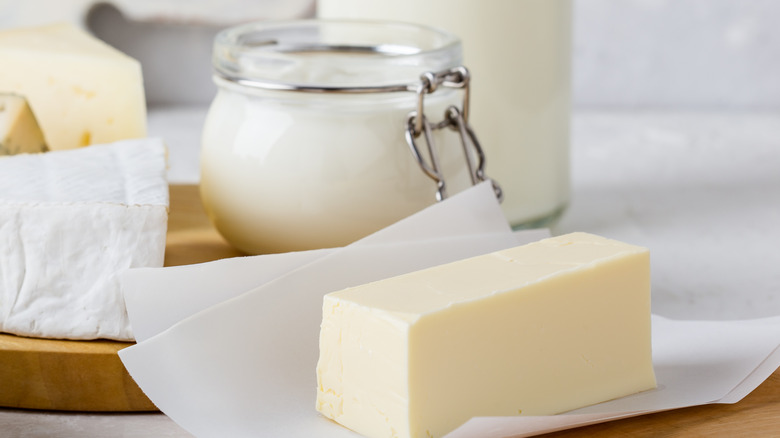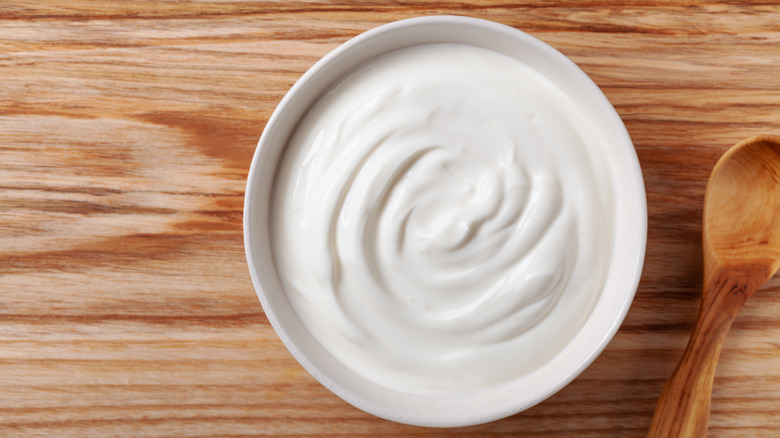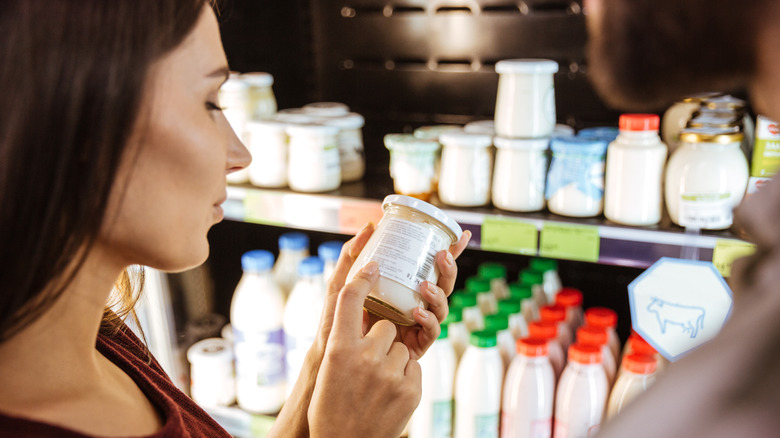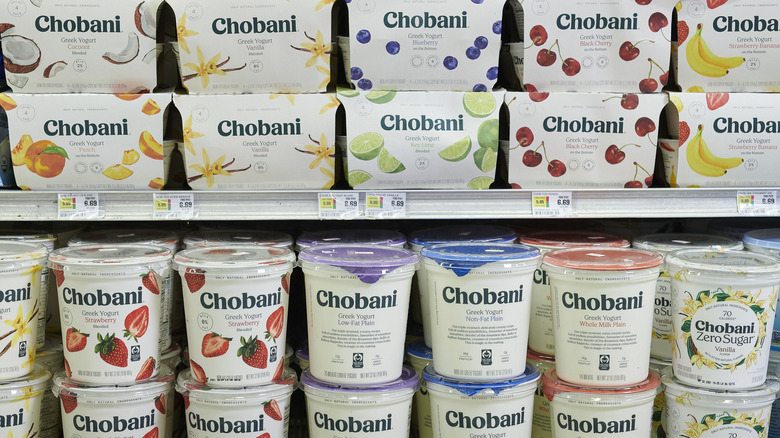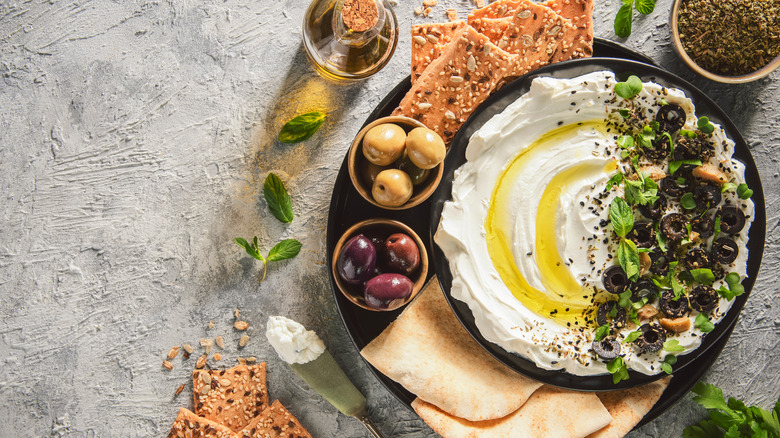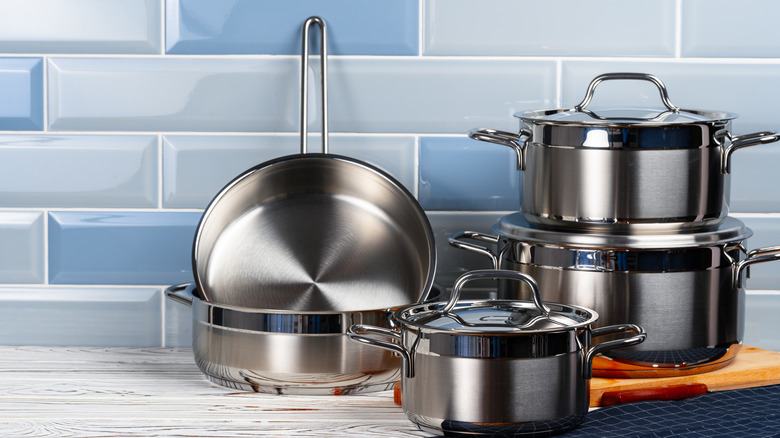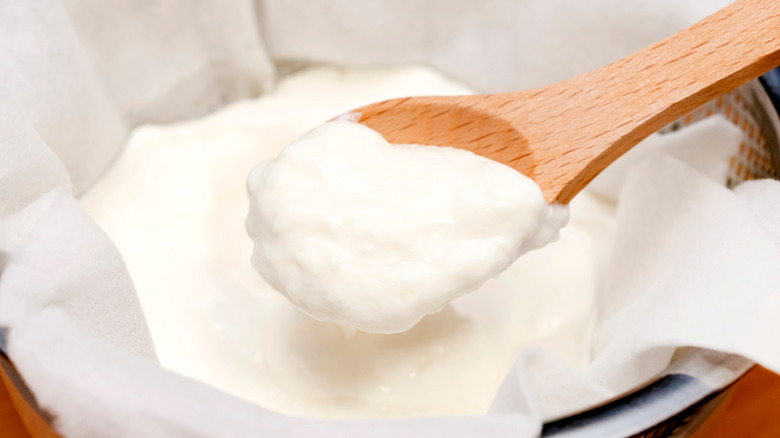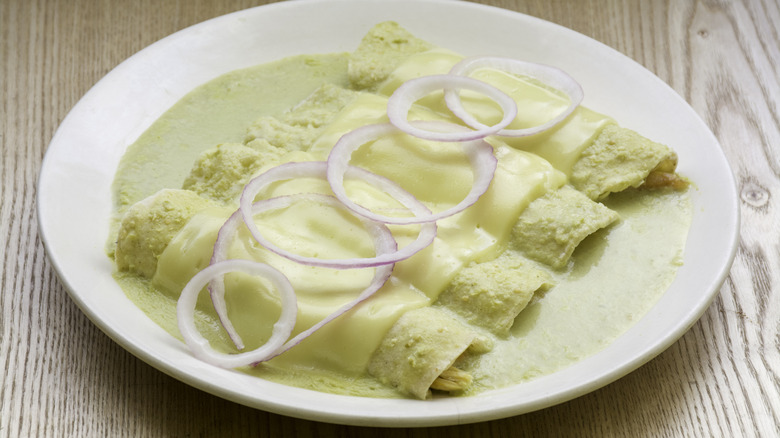The Do's And Don'ts Of Cooking With Greek Yogurt
Greek yogurt is tangy, creamy, and delicious all by itself, but it also makes a great cooking ingredient in an abundance of recipes. It's a healthy alternative to other fatty ingredients like sour cream, heavy cream, and buttermilk. It also adds a rich, creamy element to many dishes and allows you to be a bit creative when cooking. Still, there's a lot to learn about when to substitute with Greek yogurt and how to implement it properly in recipes. From using the right amount to making marinades and dressings, the possibilities are endless — as long as you know about and stay away from particular applications.
To create a list of helpful tips to follow and avoid, we referenced top chef recommendations, popular recipes, Greek yogurt brand websites, dietician insights, and more. We also considered our own successes and failures when attempting to cook with Greek yogurt. Keep reading to learn everything we've discovered about the do's and don'ts of cooking with Greek yogurt so you can use it to its full potential (and avoid getting stuck with another failed recipe).
Do substitute Greek yogurt for heavy cream, buttermilk, or butter
Most people keep butter in their fridge at all times, but heavy cream and buttermilk aren't as common. Fortunately, if you come across a recipe that calls for one of these and you don't have them readily available, you can easily swap in plain Greek yogurt. It provides similar results in most recipes and also adds an extra creamy texture that takes foods to a whole new level. Plus, thanks to all of Greek yogurt's protein and probiotics, it significantly increases nutritional value. Even though you probably won't need to switch out the butter in a last-minute recipe due to necessity, you still can do a swap in order to make a dish somewhat healthier.
When substituting Greek yogurt for heavy cream, using equal amounts is appropriate. However, you'll need to make a minor adjustment with butter and buttermilk to get the proportions and texture right. If a recipe calls for 1 cup of butter, you can swap it out for ¼ cup of Greek yogurt plus ½ cup of butter. With buttermilk, you can switch out 1 cup for ¼ cup of regular milk plus ⅔ cup of Greek yogurt.
Don't heat Greek yogurt quickly
Greek yogurt is a bit fussy when it comes to heat, even though it pairs nicely with hot foods. If you heat it too quickly, it'll separate and curdle, potentially ruining your dish. To avoid making a mistake you can't take back, it is best to only add Greek yogurt at the end when your recipe is done cooking. Basically, if you're mixing Greek yogurt into a stew, wait until it is completely done and removed from the heat before stirring in the yogurt. Pulling the Greek yogurt out of the fridge for a while beforehand is also an excellent way to raise the temperature gradually. If it goes into a recipe at room temperature, it won't be so much of a shock that the components curdle. If you need to reheat a dish with Greek yogurt in it, always stick to low heat.
While Greek yogurt's temperamental relationship with heat makes baking with it somewhat more complicated, it is still possible. You just have to thin it out a bit before incorporating it into a recipe like raspberry yogurt muffins. That way, it'll perform more like regular yogurt, which has a thinner consistency.
Do monitor the temperature of Greek yogurt
Greek yogurt tends to heat up quickly, even if you just leave it out on the counter. As it gets warm, its texture becomes thin and runny. This is not a sign that it has gone bad; it just makes it less than ideal for many recipes. For example, you want Greek yogurt to be thick and creamy when using it for marinades, dips, or as a garnish. Otherwise, your recipes won't achieve the right texture. A thinner consistency may not be as big of a deal if you're substituting Greek yogurt for butter, heavy cream, or buttermilk, but starting with it chilled is best for most other applications.
Luckily, Greek yogurt also chills relatively quickly. So, if you accidentally leave it out too long, you can easily restore its original texture by putting it in the fridge for a bit. Depending on how warm it is, about 30 minutes to an hour should be plenty. After some time, take it out, give it a stir, and it should be ready for any recipe you like.
Don't cook with or consume spoiled Greek yogurt
This may seem pretty apparent, but you should avoid using Greek yogurt that has gone bad in recipes. You don't want to eat it plain, for that matter, either. The expiration date on your Greek yogurt serves as a good indicator as to whether it is still suitable for consumption. However, expiration dates are more like guidelines and predictions than concrete deadlines. You may still be able to use a product for a few days after the printed expiration date.
Before you dive right in and accidentally ruin a recipe, make sure to smell your Greek yogurt if you don't already know for certain that it is fresh. If it smells sour or rancid, tossing it in the trash is best. If the smell is questionable, taste a small amount and see what you think. Some people get a slightly sour smell or taste from Greek yogurt even when fresh, but your nose and taste buds combined will know if it is spoiled.
If your Greek yogurt has gone past the point of a sour smell, it can also develop mold and a yellow film on top. When this occurs, do not taste it. Throw it away immediately. This should be even more obvious than getting rid of a sour-smelling batch, but sometimes mixing ingredients into recipes can save them when they are slightly past peak freshness. This is not one of those cases, though.
Do use Greek yogurt for marinades, dressings, and sauces
Greek yogurt really shines in marinades, dressings, and sauce recipes. Its thick texture helps it cling to meats, salads, and more, distributing tangy flavor and moisture throughout. When it comes to marinades, Greek yogurt is the perfect addition to dishes like grilled tandoori chicken. It makes the meat extra juicy and helps the other seasonings stick, better coating the dish in flavor. If the mixture starts to get too warm and lose its clinginess, simply toss it in the fridge for a bit so it has a chance to rethicken.
Homemade ranch dressing also gets a serious flavor and texture boost when made with Greek yogurt. Of course, its thicker consistency also helps it stick to salads or anything you might want to dip in it exceptionally well. Plus, it adds some extra nutrition to a dressing that is not really considered the healthiest. While less common, you can also make a yogurt bechamel sauce with Greek yogurt. However, due to its tendency to separate over the heat, make sure you don't add the yogurt until the end. The result is extra creamy, tangy, and the perfect complement to pasta, veggies, meats, and more.
Don't use flavored Greek yogurt by accident
When a recipe calls for Greek yogurt, nine times out of 10, plain yogurt is what you need. There are a few exceptions, but if you're actually cooking with it, unflavored is essential. Vanilla Greek yogurt looks just like plain, but the last thing you want is to add vanilla Greek yogurt to a savory recipe. If you accidentally do confuse the two, you'll likely have to scrap the dish. After all, who wants vanilla yogurt on their tacos or chili? Flavored yogurt also makes a mess of savory dips, marinades, and sauces, so avoid this fatal mistake at all costs.
Of course, flavored Greek yogurt could be acceptable for use in yogurt parfaits and other recipes that don't require any cooking. Shoot, fruity or vanilla-flavored yogurts may even be preferred if you're mixing them with berries and granola. Flavored Greek yogurt is also okay if you use it as a creamy secret ingredient in muffins, but for the most part, reach for unflavored when making just about everything else.
Do substitute Greek yogurt for sour cream and mayo
Substituting Greek yogurt for sour cream is becoming increasingly common. Plain Greek yogurt tastes similar to sour cream, but its protein and probiotic-packed composition make it a healthier alternative. Greek yogurt also has less fat and fewer calories than sour cream. When you swap out sour cream for Greek yogurt, it adds a nutritious, rich element to various dips (including simple two-ingredient dips), sandwiches, and wraps. It also makes a wonderful garnish for stews, baked potatoes, and a myriad of Latin foods, like tacos, burritos, enchiladas, and more.
You can also incorporate more Greek yogurt into your diet by using it in place of mayo. Again, it is a healthier alternative. It is also extra creamy comparatively, giving dishes a velvety smooth texture and a distinct tanginess that tastes amazing with all kinds of ingredients. You can spread a thin layer of Greek yogurt on sandwiches, or make a creamy chicken or tuna salad without mayo. Swapping mayo for Greek yogurt is also a fantastic option for anyone with an egg allergy.
Don't use aluminum cookware with Greek yogurt
Aluminum cookware is no friend of Greek yogurt. Actually, it's more like its worst enemy. When they interact, the acidity of Greek yogurt has an adverse reaction with aluminum and has the potential to absorb some of the metallic flavors. Yuck. Aluminum also heats up super quickly, which should be avoided when cooking Greek yogurt.
Before you get too worried about your cookware and whether or not it is safe for cooking with Greek yogurt, there are ways to easily find out. First, your cast iron and non-stick cookware pieces are safe. However, you might have to perform a few tests to tell if a piece of cookware is stainless steel or aluminum. The most straightforward test is to see if it is magnetic. Stainless steel has a slight magnetic attraction, and aluminum does not. This test isn't foolproof because some stainless steel pans may not attract your kitchen magnets, but it doesn't give you false results regarding aluminum.
Do make frozen yogurt with Greek yogurt
Freezing Greek yogurt is easy and opens up a world of creative dessert recipe options. Just like the frozen yogurt you get from a boutique shop, the homemade version has a delicious texture and taste that makes it the perfect base for an array of salty, crunchy, and sweet toppings.
In case you were wondering, freezing Greek yogurt won't kill its inherent probiotics, either. So, you still get a bunch of nutritional benefits that you wouldn't get if you opted for ice cream. Freezing Greek yogurt is also an outstanding way to increase its shelf life. If you have too much or it's about to go bad, simply toss it in the freezer, and you'll be able to use it for a couple of months, which is way longer than the couple of weeks an opened container lasts in the fridge.
Some of our favorite frozen Greek yogurt recipes include yogurt ice pops with blackberries and frozen yogurt cookies. You could always toss it in an ice cream maker, too, but something about the fun shape of cookies and their endless potential for inspired dessert creations makes us extra excited. Plus, you don't need an extra appliance to get the job done.
Don't try to make Greek yogurt until you've mastered regular yogurt
Considering all the potential health benefits of Greek yogurt, you may be thinking that you should try making it at home. While it can be extremely rewarding, the process is somewhat complicated. So, our recommendation is to stick to buying it from the store, at least until you've mastered a regular homemade yogurt recipe.
Regular American yogurt is not the most straightforward recipe to execute. It requires lots of patience, precise measurements and timing, and quite a few steps to get the job done right. Then, to make the transition from regular yogurt to Greek yogurt, the mixture must be strained through cheesecloth one to three times to remove the whey and other liquids. Not only is this time-consuming, but it also leaves you with much less yogurt in the end, it's messy, and it has a lot of margin for error.
If you think you're ready for the challenge, go ahead and give making Greek yogurt a try. Who knows? You might surprise yourself, and if you do, you could potentially save yourself a bunch of money. You won't save yourself any time, but everything tastes better when it's homemade, so it may be more than worth the extra effort.
Greek yogurt recipes you have to try
Greek yogurt is as versatile as it is delicious. In addition to all of the creative recipes sprinkled throughout this article, there are plenty of other ways to cook with Greek yogurt that will leave you craving more. If you like spicy foods, incorporate Greek yogurt into creamy enchiladas suizas with chicken by using it in place of crema. Or, add a spoonful to a Greek pita pizza before serving for added flavor and texture. Chicken salad-stuffed avocados are perfect if you want a dish that is just as eye-catching as it is drool-worthy.
Greek yogurt also goes great with eggs. You can top scrambled eggs with it or add a dollop to the center of a rosemary and olive frittata for the perfect mix of textures. You can also whisk Greek yogurt into eggs to make Turkish-style poached eggs bursting with tangy flavors and creamy goodness. You'll be amazed at how much a dollop of Greek yogurt intensifies flavor in all the best ways.
Lastly, French yogurt cake is the perfect way to end any meal. It's light and sweet, and as you may have guessed by now, it has a bit more nutritional value than a regular cake. Pair it with frozen Greek yogurt and get the best of both dessert worlds.

